|
July 1936 Radio-Craft
 [Table
of Contents] [Table
of Contents]
Wax nostalgic about and learn from the history of early electronics.
See articles from Radio-Craft,
published 1929 - 1953. All copyrights are hereby acknowledged.
|
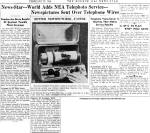 It really was not all that long ago when
wiring images for news stories literally meant transmitting photographs over a twisted
pair of telephone lines either to a fax machine or to a computer on standby waiting
for incoming files. Videocasts were being regularly performed via satellite of ground
relay microwave stations since the 1960s, but most still shots were sent via phone
lines. For the last decade and a half, both still shots and videos have been transmitted
as a routine matter via camera-equipped cellphones, and as with most technologies
we have quickly become so accustomed to the convenience that memories of the old
ways are quickly (even thankfully) forgotten. This article from a 1936 edition of
Radio-Craft describes one of the really early systems. Notice that coupling
to the telephone line is via induction to the handset, not via a hardwire connection
to the phone circuit. The thumbnail on the left links to a 1940 news story in the
Monroe, Louisiana News-Star newspaper boasting of its newly acquired telephone
photo system. It really was not all that long ago when
wiring images for news stories literally meant transmitting photographs over a twisted
pair of telephone lines either to a fax machine or to a computer on standby waiting
for incoming files. Videocasts were being regularly performed via satellite of ground
relay microwave stations since the 1960s, but most still shots were sent via phone
lines. For the last decade and a half, both still shots and videos have been transmitted
as a routine matter via camera-equipped cellphones, and as with most technologies
we have quickly become so accustomed to the convenience that memories of the old
ways are quickly (even thankfully) forgotten. This article from a 1936 edition of
Radio-Craft describes one of the really early systems. Notice that coupling
to the telephone line is via induction to the handset, not via a hardwire connection
to the phone circuit. The thumbnail on the left links to a 1940 news story in the
Monroe, Louisiana News-Star newspaper boasting of its newly acquired telephone
photo system.
Sending Pictures by Telephone
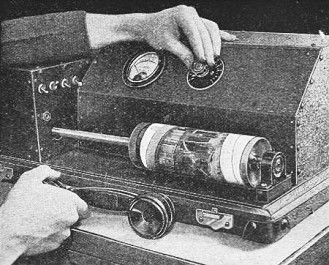
Fig. A - The portable transmitter in use. Note hand held
over transmitter.
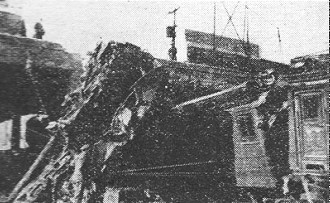
Fig. B - An example of a transmitted picture.
 A newly-perfected system for sending news photos
over ordinary telephone lines is here described. The portable transmitter is not
connected directly to the line but is merely placed close to the telephone instrument.
A "picture" may be telephoned at night from coast to coast for only $25! A newly-perfected system for sending news photos
over ordinary telephone lines is here described. The portable transmitter is not
connected directly to the line but is merely placed close to the telephone instrument.
A "picture" may be telephoned at night from coast to coast for only $25!
Andrew Halbran
One of the most important aids to the modern high-speed dissemination of pictures
of news events has come to light recently with the release by the New York Times
of data on a system of wire transmission of photos, developed by its subsidiary,
Wide World Wired Photos. This new method employs the wires of the telephone companies,
and in some cases those of the telegraph carriers as well, without actual connection
to the circuit. The impulses from the portable transmitter are transferred to the
lines by induction only, and will function anywhere there is an ordinary telephone
line, which is the feature that makes its field so enormous.
The transmitters, as seen in Fig. A, are of the portable type, and weigh
about 50 lbs., packed in their carrying cases, which are not much larger than a
good-size suitcase. If operation is to be accomplished at a point where line power
is not available, the equipment may be operated from any 6 V. source, such as a
storage battery. A 15-lb., airplane-type battery will supply sufficient current
to transmit 8 full-size (7 1/4 x 8 3/4 in.) images or "pictures."
The receivers, as seen in Fig. C, are of the rack type since they need not
be portable, and may be operated in either light or dark locations.
Actual operation of both transmitters and receivers is very simple. An ordinary
glossy photo is secured to the drum of the transmitter, which in operation revolves
45 times per minute. As it turns, a spot of light photo to a photo-cell, the resulting
current being combined with an 1,800-cycle signal. This combination signal is then
amplified and applied inductively to the line. (It is only necessary to cover the
transmitter of the telephone instrument, so as to prevent pick-up of external noise.)
An ordinary station-to-station call is then made over the telephone to the newspaper
office; (later, use may be made of the "conference wires" whereby the pictures may
be sent from one point and received simultaneously at several different cities).
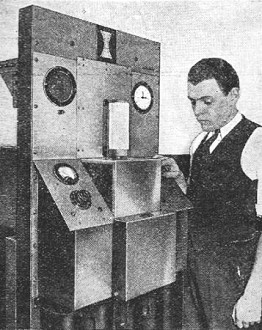
Fig. C - Rack-type receiver; note image cylinder.
At night rates, a 6 1/2 x 8 1/2 ins. picture would cost a maximum of about $25.00
if sent from coast to coast, and could be sent in about 15 mins.
The receiving end operates almost as simply. The operator places a drum carrying
a sheet of sensitized paper upon a vertical spindle on the panel. A pick-up coil
placed close to the telephone instrument is connected to the amplifying system of
the receiver, and the amplifiers and synchronizer adjusted, the latter process being
extremely simple.
While the process is somewhat similar to that used by other news systems, it
differs in several important points, one of the most radical departures of course,
being that the portable transmitters may be used anywhere there is an ordinary telephone
line available. Another difference is that the new apparatus is so well synchronized
that perfect pictures may be sent over the "carrier circuits," used quite extensively
in the Southwestern portion of the U. S. Transmission over these circuits heretofore
has resulted in such distortion that the pictures were totally unusable.
The perfection of the transmissions may be seen by reference to Fig. B,
which shows an unretouched photo of a railroad wreck as reproduced over the system;
and Fig. D, also unretouched illustrating an actual "news" occurrence.
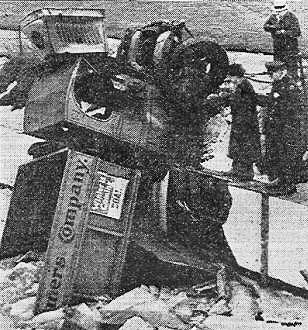
Fig. D - Note the remarkable detail.
In Fig. 1, our artist has shown the sequence of operation. First the reporter
snaps a picture of a wreck, which is then quickly developed, and transmitted over
the telephone in the village general store. The reader will easily understand the
importance of this rapid system in the dissemination of illustrated news stories.
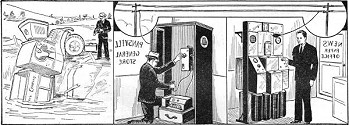
Fig. 1 - The 3 steps. First the picture is taken, then developed;
second, it is sent over the line; and third, received (as shown in Fig. D at
the newspaper office.
Posted January 7, 2021
(updated from original post on 3/29/2016)
|












 A newly-perfected system for sending news photos
over ordinary telephone lines is here described. The portable transmitter is not
connected directly to the line but is merely placed close to the telephone instrument.
A "picture" may be telephoned at night from coast to coast for only $25!
A newly-perfected system for sending news photos
over ordinary telephone lines is here described. The portable transmitter is not
connected directly to the line but is merely placed close to the telephone instrument.
A "picture" may be telephoned at night from coast to coast for only $25! 


